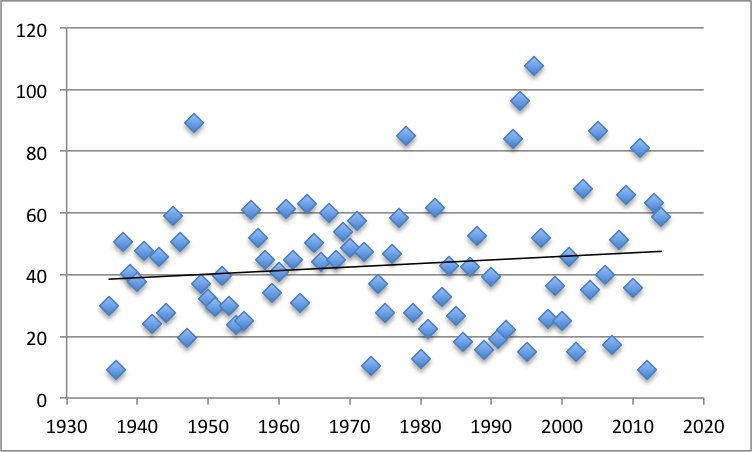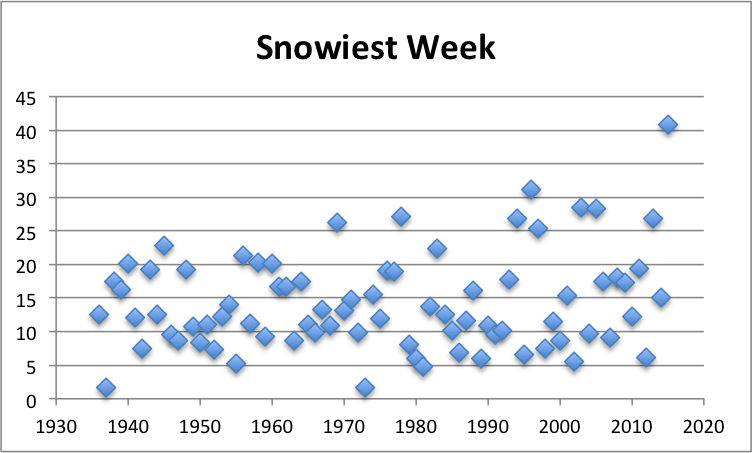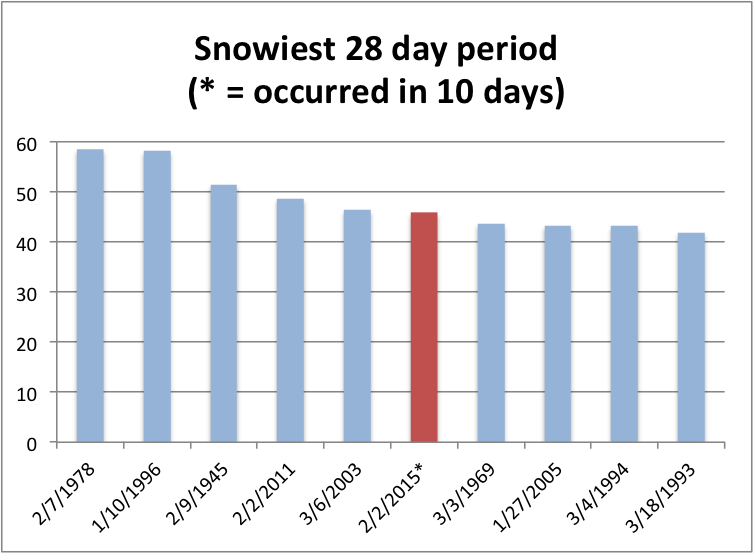 |
| How unprecedented is three and a half feet of snow in a week? Very. |
The calls have gone out. The T screwed up. Some yammer that “it was much worse when I was young” (and we walked uphill to school in it, both ways). Some tell the MBTA that they should be prepared for winter, come on, it’s just a little bit of snow.
The thing is, it is way more snow that has ever fallen. Ever.
How many ski resorts in the US average 6 inches of snow every day (assuming all the snow falls in four months—which it doesn’t)? Zero. Sure, once in a while Squaw or Alta will see 800 inches of snow in a year (2011), and Mount Washington once tallied 567 inches in a year, but the averages are lower. Buffalo might get five feet of snow in a week, but not every week. 40.8 inches of snow a week from December through March adds up to 692 inches of snow. Or 58 feet. What I’m trying to say is that no one, anywhere, is really used to getting three and a half feet of snow a week.
I took the pains of pulling the last 79 years of Boston’s weather data from the National Climate Data Center. It goes back further, but from a different site—not at the airport—which would have required another data pull. Plus, in 1936 the T, well, BERy, was very different, no major highways had been built, and anyone who is under 90 can’t really remember that much from the mid 30s anyway. Sure Grandpappy may go on about the hard winter of ’23, but he also was yelling at Fox News for 45 minutes yesterday. (Here’s the annual data back to 1892, by month)
Anyway, back to the data. In the 7 days ending February 2, there were 40.8 inches of snow. This is unprecedented. The previous record was 31.2 inches, so not only did we break the record, we smashed it by 30%. This would be like if Mark McGwire had broken Roger Maris’s record of 61 home runs and hit 79, and it should be noted that he did this with a second head growing out of his neck. The record wasn’t just broken. It was smashed.
The past two weeks have also seen the snowiest 4 days on record, the snowiest 5 days on record, the snowiest 6 days … well, you get the idea. All the way up to the snowiest two weeks on record. Take any time period between three days and two weeks, and the amount of snow that has fallen in the past couple of weeks has eclipsed anything that has ever happened. So, sorry, Grandpa, it wasn’t like this all the time when you were young. It was never this bad.
 |
| Annual snowfall in Boston |
Even if you take it out to four weeks, the 10 days ending February 2 are actually 7th on the list. (Unlike some “analysts“, I did not use bizarre rolling averages to pump up the numbers. Any time a date was duplicated, I discarded all but the highest. Also, go Patriots!) If another 13 inches of snow falls in the next 18 days, 2015 will have the highest four week snowfall in history. Looking at the weather models for the next few days, I’d take the over.
So, Grandpa was wrong. It was never like this when he was young. (And despite climate change, the annual snowfall totals are trending up, although there appears to be more variability, too.)
So let’s get to the second part: shouldn’t the T be prepared for winter? Doesn’t winter come pretty regularly every year? Sure. And they probably are. But here’s the thing: winters are variable, and the T is not prepared for all of winter to come in a period of 8 days. If you’re following along, in the 8 days ending on February 2, Boston had 46 inches of snow. That’s Buffalo territory. Hell, that’s Houghton, Michigan-like. And it’s more snow than falls in an average year.
 Since 1936, the average snowfall in Boston has been 43 inches. The median is 40.9—a few big winters skew the total up, and since negative snow can’t fall, the floor is 0. Since 1892, just 45 winters have had more than 46 inches of snow. So the past eight days have had more snow than 64% of the winters in the past 122 years. I don’t fault the T for not preparing for this: it’s something that is really off the charts.
Since 1936, the average snowfall in Boston has been 43 inches. The median is 40.9—a few big winters skew the total up, and since negative snow can’t fall, the floor is 0. Since 1892, just 45 winters have had more than 46 inches of snow. So the past eight days have had more snow than 64% of the winters in the past 122 years. I don’t fault the T for not preparing for this: it’s something that is really off the charts.
The average highest seven days of snowfall in a year is 14 inches. The standard deviation is 7.12 inches. 40 inches is about three and one half standard deviations above the mean. If we make the assumption that these data are normally distributed (and the numbers are 72% within 1 stdev, 96% within 2, and 97.2% within 3, although of course before this year it was 98.7%; this lines up pretty well with the 68/95/99.7 normal distribution despite our relatively small sample size), this amount of snow is something we’d expect less than once every 100 years. Should the T be completely prepared for a once-in-a-century occurrence? Should we spend tens of millions on snow clearance preparation when we’re just as likely to have a winter with a foot of snow as a single week with three feet? With a tight budget, you need priorities, and one of the T’s priorities has been running on a lean staff. No longer are there track gangs who sit by idly all winter waiting for snow. And preparing for—and staffing up for—the proverbial 100 year storm is probably not at the top of the T’s list.
So cut the T—and the highway crews, and the guys in front-end loaders clearing curbs—some slack. They’re dealing with something they’ve never seen before, and it’s amazing that the transportation system is working at all. This is not what your parents dealt with every winter back in the day. This is not something that the T could have remotely been prepared for. It’s never happened before. And if the current weather models hold up, the snow is not anywhere close to done.
If we’re lucky, this might be the jolt that politicians need to move the needle away from “blame the T” to “let’s see if we can do something about the T.” This might be the MBTA’s Muni Meltdown moment (although calling it a meltdown wouldn’t really work). Hopefully something good will come of it as we have a necessary conversation about adequately funding the system (and not just the Olympics).
Oh, let’s just hope there’s somewhere to put all the snow.


Well said! Too many complainers to begin with.